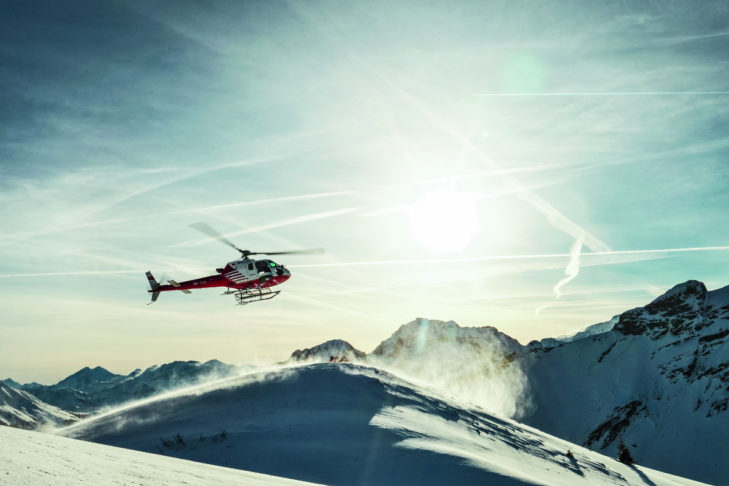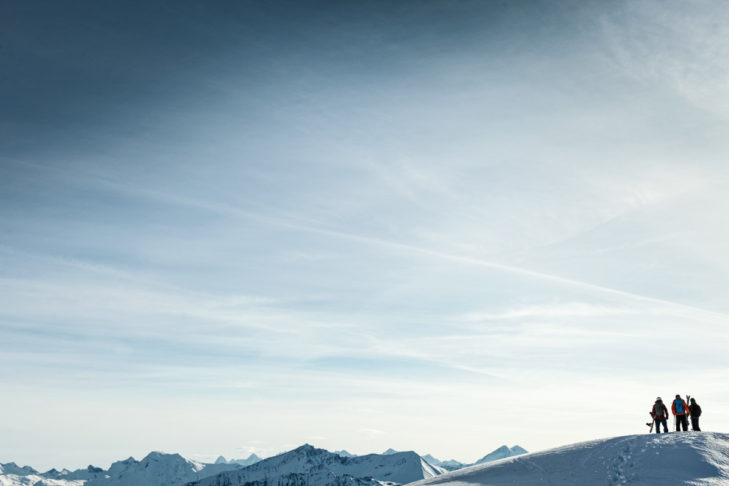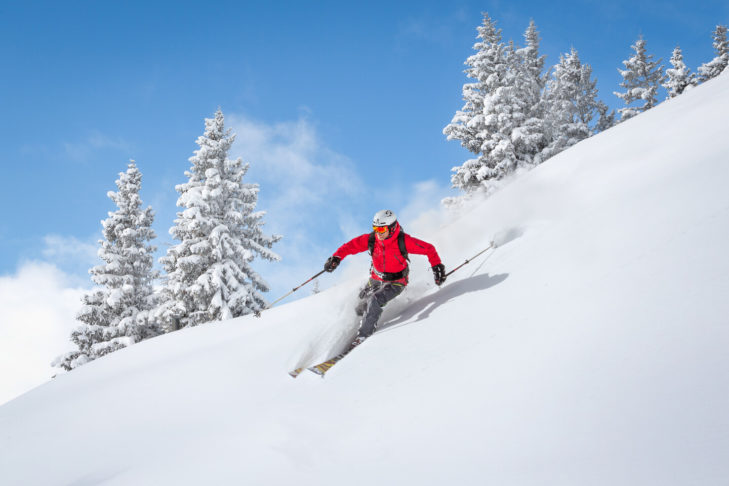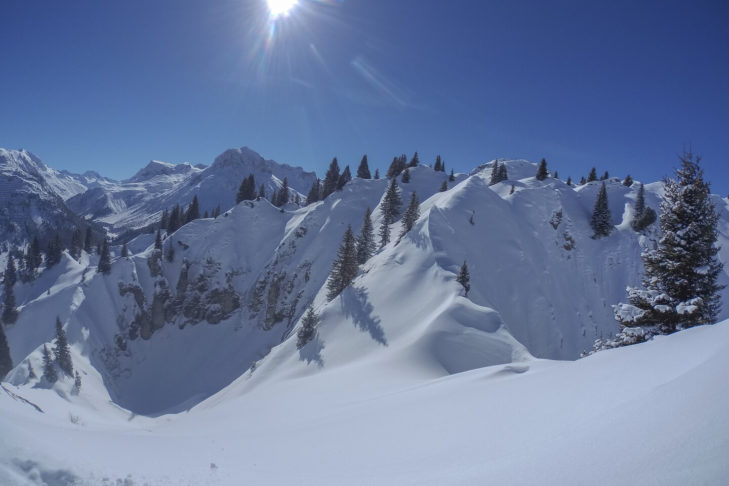Carving through glistening deep snow, feeling the freedom of wide glaciers and the wind in your face, travelling through forests that perhaps no one has ever been to before – what sounds like the dream of every passionate skier is now an integral part of winter sports: heliskiing. SnowTrex has researched and explains everything about heli-skiing below.
The fascination of heliskiing/heliboarding
Many snow enthusiasts cherish the desire to glide down the valley along wide deep snow slopes surrounded by dreamlike mountain landscapes. This experience is particularly appealing when it does not take place on the side of the pistes or underneath lifts, but in places where only a few people have skied or snowboarded before. Most people find the time-consuming and strenuous ascent of a classic ski trip too time-consuming. So why not simply scale the mountain by helicopter? Whether you’re a skier or snowboarder – heliskiing takes you to places that get every winter sports enthusiast’s heart racing. After the flight, breathtaking expanses open up at altitudes of up to 4,000 metres. The view of sparkling glacier massifs and snow-covered mountain worlds alone is an experience you won’t soon forget. But of course, the solitary descent through the untouched powder is the highlight of this adventurous endeavour. So let’s go – put on your skis and set off on a unique heliskiing experience.
High up with the helicopter
Heliskiing involves skiers being flown by helicopter high up into the mountains or onto a glacier, where they are dropped off in the “wilderness” and from there embark on a descent the likes of which they have probably never experienced before. Even during the flight, a very special atmosphere spreads throughout the helicopter. The passengers in the helicopter are bursting with anticipation and excitement as they admire impressive rock formations and vast snow-covered slopes from a bird’s eye view. In order to arrive as early as possible in the ‘El Dorado’ of powder, everyone involved gets up in the dark of night – after all, skiing in the first rays of sunshine of the day is sheer bliss.
Before heading up the mountain, a few precautions must first be taken so that everyone involved is optimally prepared for the adventure. It is advisable to wear several layers of clothing to be prepared for all weather conditions. In addition to choosing the right clothing, it is important that all passengers are familiar with the correct use of avalanche and first aid equipment. They should be familiar with the correct use of avalanche transceivers, probes and shovels as well as an airbag rucksack so that all the winter sports enthusiasts can react well in dangerous situations.
Once the safety precautions have been taken, nothing stands in the way of the helicopter flight. Once at the top, the passengers are released into their skiing adventure near a summit or mountain flank.
The descent
Getting out of the helicopter and arriving at the starting point is quite something, as the panorama is indescribable. After savouring the view and inhaling the fresh mountain air, it’s time to head down the mountain.
Departure accompanied by a guide
Skiers are accompanied on their descent by a so-called “guide”. These are experienced, professional and, above all, local ski instructors or mountain guides who are specially trained for skiing in the wilderness. They ensure both the safety of the participants and that nature is not detrimentally affected by the skiers.
In the morning, the participants have a meeting with the guides to discuss the current weather and snow conditions. As part of a risk analysis, the potential dangers and the current avalanche situation and cornices are discussed. A computer collates the collected information and creates a list of descents. The colour red represents descents that cannot be skied and green those that can be skied. The pilot also performs an analysis and checks whether the location selected for the drop-off can be flown to. This results in the final departure destination. Safety is always the top priority and conditions can change quickly. The final decision as to whether or not to descend is therefore only made on arrival at the summit.
Following the risk analysis, the participants receive a safety briefing. Among other things, they are instructed on how to behave during the helicopter flight, during the descent and how to use an avalanche transceiver. After all, as experienced as the guides are, nature is ultimately an unpredictable force and safety on the unprepared pistes is the top priority without exception.
The downhill experience
On the run into the valley, where skiers and snowboarders often cover over 1,000 metres in altitude, there are no lifts, cable cars or ski huts to be seen far and wide, and encounters with local wildlife such as eagles, chamois or marmots are not uncommon. Skiing through the fresh powder and along undiscovered snow and forest landscapes gets every nature lover’s heart beating faster.
Despite the unique downhill experience, some rules of behaviour should undoubtedly be observed. In addition to being aware of possible avalanche hazards and difficult piste conditions, it is particularly important to keep your bearings at all times. The guide must not be left too far out of sight, as otherwise individual participants may get lost. Communication during the descent is also the be-all and end-all. Even in difficult conditions, for example due to poor visibility, care should always be taken to ensure that communication between the guide and participants is maintained. Good communication not only helps with orientation, but is particularly helpful in dangerous situations and for the rapid rescue and recovery of a buried victim. The most important rule, however, is that every participant follows the guide’s instructions. With their experience, they are best placed to assess dangers such as changes in the weather and dangerous avalanche and piste conditions and should therefore enjoy the trust of every participant.
Heliskiing is also suitable for “non-pros”
Contrary to many expectations, heli-skiing is not just for professionals, but for any skier who has already gained experience on more challenging red and black pistes, has speed and manoeuvrability and has already made their first small off-piste excursions. It is also important to have a good personal assessment of your fitness and ability on the slopes. Winter sports enthusiasts should also be in good physical condition. The altitude, bad weather and icy sections can be extremely challenging, even for experienced winter sports enthusiasts. However, as soon as these requirements are met, nothing stands in the way of an unforgettable holiday experience – adrenaline rush included.
Please also note that by using our services and integrating the YouTube API Services, the YouTube Terms of Service and the YouTube API Services Terms apply and your use of our website is deemed to be acceptance of these terms.
Heliskiing in Austria
You don’t always have to cross the Atlantic to experience a unique heliskiing tour. Austria is also the perfect place to try out heliskiing. Lech am Arlberg in particular offers snow lovers a whole range of first-class freeride spots. Adventurous skiers and snowboarders with good technique can take a helicopter to the Mehlsack, while beginners can aim for the area around the summit of the Orgelscharte. For optimum snow conditions, you should choose the period from December to March. In the winter months, winter sports enthusiasts will find top conditions here for a unique heli-skiing experience. Thanks to the high snow probability, deep-snow skiers can look forward to fantastic powder snow, which enables unique deep-snow experiences.
Heliskiing in Switzerland
In the immediate vicinity of Austria, snow lovers will find what is probably the most popular heliskiing destination in the Alps: the unique Switzerland. In Zermatt, a true heliskiing ‘El dorado’ can be found around the impressive Matterhorn. Numerous providers transport snow lovers into the unspoilt mountain world and to a multitude of unique and breathtaking deep-snow descents.
Another particularly popular destination is the Monte Rosa massif in the Valais Alps. Early in the morning, head up to the Plateau Rose, which lies at an altitude of around 3,100 metres. In the light of the sunrise, you can make your first tracks in untouched powder against an impressive backdrop. Surrounded by gigantic mountains such as the Breithorn and Lyskamm, ski adventurers will find some of the longest powder runs in the world here. Daring skiers and snowboarders head to the summit of the Dafourspitze. From an altitude of over 4,000 metres, the descent down the mountain offers breathtaking views. However, it should be noted that the heliskiing tours in Zermatt should only be attempted by skiers or snowboarders with good skills due to their length and the large number of metres in altitude that have to be conquered.
Heliskiing in Italy
Winter lovers travelling to Italy for heliskiing will find what they are looking for in Valtellina. Valtellina is one of the longest Alpine valleys and stretches between Lake Como in the west and the Ortler group in the east. A large number of side valleys form the border to the Bernina Group in the north, where Italy borders Switzerland. In these very valleys and the surrounding slopes, there are plenty of tours that can be flown to by helicopter. Breathtaking views, vast snow and forest landscapes and fresh powder as far as the eye can see. You can easily get there by car. To round off heliskiing in Italy, the Valtellina cuisine invites you to savour traditional delicacies in the evening. These and other amenities will make your heliskiing tour in Italy an unforgettable experience.
Heliskiing in Canada
Snow lovers will find an absolute top spot for heli-skiing in British Columbia in Canada. The snow-covered region is a destination of superlatives. Covering a total of 10,700 km² and at altitudes of up to 4,000 metres, the Bella Coola area is the largest contiguous heliskiing area in the world. The absolute highlight here are the coastal mountains. From the peaks, which are over 4,000 metres high, skiers and snowboarders can enjoy spectacular views of the Pacific Ocean and secluded fjords. Ambitious winter sports enthusiasts can experience narrow rocky gullies, huge glaciers and countless adventurous forest descents. With a variety of steep and long descents, heliskiing in Canada is particularly suitable for experienced skiers and snowboarders with good stamina, but beginners will also find the right descent for them.
Where is heliskiing possible?
Heliskiing is offered in or near the following ski resorts from the SnowTrex selection of offers:
| Ski resort | Country |
|---|---|
| Lech am Arlberg | Austria |
| Chamonix | France |
| Monte Rosa | Italy |
| Livigno | Italy |
| Courmayeur | Italy |
| La Thuile | Italy |
| Alagna Valsesia | Italy |
| Val Madesimo | Italy |
| Mürren | Switzerland |
| Grindelwald | Switzerland |
| Meiringen | Switzerland |
| Gstaad | Switzerland |
| Davos-Klosters | Switzerland |
| Flims-Laax-Falera | Switzerland |
| Arosa-Lenzerheide | Switzerland |
| Zermatt | Switzerland |
| Monashee Mountains | Canada |
| Monashee Mountains | Canada |
| Monashee Mountains | Canada |
Heliskiing costs
The cost of a heliskiing tour varies depending on the length, location, type of included services and the seasonal period. Generally speaking, the low season (December and January) is the cheapest. If a heliskiing tour is booked in the late season (April), the costs increase. The most expensive tours take place in the high season (February and March). The most vertical metres can be skied in these winter months, as the average snowfall and snow conditions as well as the daytime temperatures offer optimal conditions for the solitary deep snow descents.
The prices are of course also largely dependent on the duration of the trip. For example, a four-day heliskiing tour in Canada can cost up to €7,000 in the high season. It should be noted that the price often includes numerous inclusive services. The offers include bus transfers to the accommodation, the accommodation itself, mountain guide services, ski and snowboard equipment and the necessary safety equipment.
However, there is also the opportunity to get a taste of the world of heliskiing as part of a day tour. Of course, this is not quite as expensive. For example, day trips to the Arlberg in Austria cost around €550 per person. This includes the flight, but the mountain guide must be booked separately. Although heliskiing is no bargain, the unique experience on the highest peaks and unspoilt slopes of various mountain regions will certainly never be forgotten.
FAQ’s
What is heliskiing?
Heliskiing describes a ride in a helicopter up into the mountains or onto a glacier. In some cases, altitudes of over 4,000 metres are reached before skiing or snowboarding back down to the valley through fresh powder and along snow-covered peaks.
How much does heliskiing cost?
The cost of a heliskiing tour varies depending on the length, location, number of included services and seasonal period. The peak season is the most expensive. Heliskiing tours in Canada are also more expensive than tours in Austria. Day tours on the Austrian Arlberg, for example, cost around €550 per person without a mountain guide included. In Canada, the cost of a four-day tour with a wide range of included services is around €7,000.
Where can I go heliskiing?
Heliskiing is possible worldwide. Heliskiing in Europe is possible in Austria (e.g. Arlberg), Switzerland (e.g. Zermatt) and Italy (e.g. Valtellina). After a flight to the top of the impressive peaks, ambitious winter sports enthusiasts are offered a unique view. Many winter sports enthusiasts also make their way to the heliskiing ‘El dorado’ of Canada. British Columbia is home to the largest contiguous heliskiing area in the world.
Why is heliskiing so special?
Flying in a helicopter is a very special experience in itself. Arriving at the summit of a mountain reveals a view over sparkling glacier massifs and impressive panoramas. Then it’s back down to the valley through fresh, untouched powder, far away from mass tourism, pistes and lifts. This is an experience that makes the heart of every winter sports enthusiast beat faster.
What do I need to be aware of before heliskiing?
It is essential to know the correct way to use avalanche and first aid equipment as well as how to use avalanche transceivers and probes. This is explained in detail by a mountain guide before each tour. In addition, every participant should follow the guide’s instructions, as the guide has the experience to best assess dangers such as changes in the weather and dangerous avalanche and piste conditions.
Can beginners also go heliskiing?
Heliskiing is suitable for any skier who has already gained experience on challenging red and black pistes, has speed and manoeuvrability and has already successfully made their first small off-piste excursions. You should also have a good self-assessment of your own abilities and be in good physical condition.












